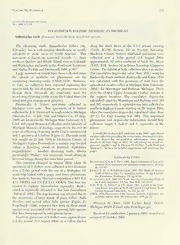
Synanthedon bolteri (Sesiidae) in Michigan PDF
Preview Synanthedon bolteri (Sesiidae) in Michigan
VOLUME 59, NUMBER 4 bo( es)O l Journal of the Lepidopterists9 Society 59(4), 2005, 235-236 SYNANTHEDON BOLTERI (SESIIDAE) IN MICHIGAN Additional key words: pheromones, Baskerville-Emin, Synanthedon sigmoidea The clearwing moth, Synanthedon bolteri (Hy, along the Rock River at the US-2 stream crossing Edwards), has a wide-ranging distribution in mostly (T43N, RIIW, Section 24) in Newton Township, sub-arctic to arctic areas of North America. This Mackinac County. Sixteen additional specimens were statement is based on scattered records, "... from collected over a 3-day period (3-5 August 2004) southern Quebec and Rhode Island west to Colorado approximately 12 miles southeast of Sault Ste. Marie and Washington and north to the Northwest Territories (T46N, RIE, Section 34) in Bruce Township, Chippewa and Alaska (Eichlin and Duckworth 1988, p. 86)" County. The habitat at both collection sites was similar. Large numbers of sesiids have been collected since The cumulative degree-day value (Base 10°C) using the the advent of synthetic sex pheromone use for Baskerville-Emin method (Baskerville and Emin 1969) monitoring clearwing moths (USDA 1979). However, was calculated with the assistance of staff from the to date, no collectors have reported capturing this agricultural weather office at Michigan State University species with the use of synthetic sex pheromones, even (MSU) for Manistique and Barbeau, Michigan. These though these chemicals are commonly used for were the closest Upper Peninsula weather stations to monitoring clearwing moths across the United States for the capture locations. The cumulative degree-day integrated pest management purposes. calculated values for Manistique and Barbeau were 394 Historically, $. bolteri specimens collected in and 385, respectively. S. sigmoidea was later collected in Michigan were rare. Two specimens of S. bolteri southern Ingham County starting on 26 August 2004, collected by R.R. Driesbach in southwestern Michigan when the cumulative degree-day calculated value (Base (Mecosta Co., 31 July, 1941 and Ottawa Co., 17 Aug., 10° C) for East Lansing was 1061. This important 1945) are located in the Michigan State University A. J. pheromone and degree-day information should help Cook Arthropod Research Collection and University of collectors target S. bolteri and S. sigmoidea in the Michigan Museum of Zoology, respectively. In over 30 future. years of collecting clearwing moths I have encountered I would like to thank Jeff Andresen at the MSU agricultural only 1 specimen of S. bolteri (Figure 1). The male moth weather office for providing the temperature data used to calcu- was caught on 23 July 1984 in Dickinson County of late the degree-day accumulation information. Also, many Michigan's Upper Peninsula in a malaise trap located thanks to Stewart Gage of MSU for calculating the actual de- gree-day numbers and to Thomas D. Eichlin, Sarah Wolf and within a flowering stand of fireweed (Epilobium Mogens C. Nielsen for helpful suggestions and reviewing this angustifolium). Another clearwing moth, Albuna paper. pyramidalis (Walker), was commonly found sitting on LITERATURE CITED fireweed foliage during this same time period. BASKERVILLE, G.L, & P. EMIN, 1969. Rapid estimation of heat accu- This situation changed in August 2004, when 30 mulation from maximum and minimum temperatures. Ecology specimens of S. bolteri were collected at two locations 50: 514-517. over a 5-day period with the use of a Multipher 1® EICHLIN,T. D., & W.D.DuckwortH, 1988. The Moths of America moth trap baited with a grape root borer pheromone North of Mexico. Fasc. 5.1: Sesioidea, Sesiidae. Wedge Entomol. Res.Foundation, Washington, DC pp.85-86. lure made by Suterra. This lure composition is 99% E,Z ENGELHARDT, G.P., 1946. The North American Clear-wing Moths of 2.13 -ODDA and 1% Z,.Z 3,13 -ODDA. This lure was the Family Aegeriidae. US Nat. Mus. Bull. 190: 84-85. chosen to capture Synanthedon sigmoidea (Beut.), Tart, W. H., D. SmITLey, & J.W. SNow, 1991. A guide to the Clear- wing Borers (Sesiidae) of the North Central United States. North which is reportedly attracted to this lure formulation Central Regional Publication. No.394. pp. 30. (Taft et al. 1991). The trap location was selected due to USDA, 1979. Pheromones of the Sesiidae (formerly Aegeriidae). Sci. the occurrence of large stands of pussy willow (Salix and Edu. Admin. ARR-NE-6 December 1979. pp. 81. discolor) and several other Salix species (Figure 2). WILLIAM H. Tart, 1430 Locher Road, Dewitt. Engelhardt (1946) reported that both of these moth Michigan 48820 E-mail: [email protected] species were associated with low growing Salix species that have been injured by coleopteran larvae. Recefoir pvubleicadti on 3 January 2005; revised and Fourteen specimens of S. bolteri were captured over accepted 21 October 2005 a 3-day period (1-3 August 2004) in a willow thicket 236 JOURNAL OF THE LEPIDOPTERISTS9 SOCIETY Ficure 1. S. bolteri collected southeast of Ralph on 23 July 1984, Dickinson County, Michigan. (Photo Credit: P. Carrington) River, Mackinac County, Michigan. (Photo Credit: Wim. Taft)
